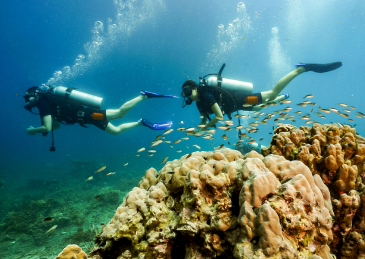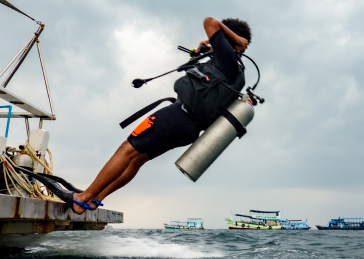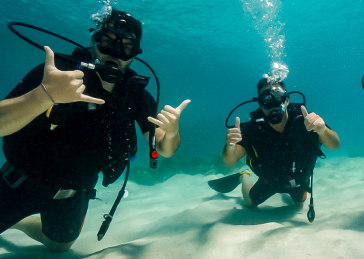23rd May 2024
-
Chemical sunscreens can harm marine life, including coral reefs.
-
Reef-safe sunscreens avoid ingredients like oxybenzone and octinoxate.
-
Mineral-based sunscreens with zinc oxide or titanium dioxide are safer for reefs.
-
Wearing protective clothing can reduce the need for sunscreen in the water.
-
Choosing reef-safe products supports the health of marine ecosystems like Koh Tao.
When we dive into the ocean, we enter a world that thrives on balance. The choices we make above the surface can have profound effects on the aquatic life below. That’s why picking the right sunscreen is more than a skin-deep decision; it’s a commitment to preserving the underwater world we love.
Why Choosing Reef Safe Sunscreen Matters for Scuba Divers

“Best Reef Safe Sunscreen | Top 10 in 2024” from www.divein.com and used with no modifications.
Most importantly, the sunscreen you choose impacts not just your skin, but also the health of coral reefs and marine life. The same chemicals that shield us from harmful UV rays can wreak havoc on underwater ecosystems, especially around popular diving destinations like Koh Tao.
The Effects of Chemical Sunscreens on Marine Life
Imagine slathering on sunscreen, thinking you’re protecting your skin. Now imagine that once you dive in, the chemicals from your sunscreen begin to leach into the water, where they can harm corals and fish. It’s a stark reality that chemicals like oxybenzone and octinoxate found in many sunscreens can cause coral bleaching and even death.
Understanding the Impact on Koh Tao’s Delicate Coral Ecosystems
Koh Tao, a jewel in Thailand’s diving crown, is known for its stunning coral reefs. These reefs are not just beautiful; they’re crucial for marine biodiversity. But they’re delicate. When divers wear chemical sunscreens, they introduce toxins that can damage these vital habitats.
RAID’s Position on Environmental Conservation
RAID, a leader in diver training, advocates for the protection of our oceans. They encourage divers to use reef-safe sunscreens and adopt eco-friendly practices, ensuring the waters remain vibrant for generations to come.
Identifying Harmful Ingredients in Conventional Sunscreens

It’s not just about slapping on any sunscreen; it’s about knowing what’s in it. Some ingredients are notorious for their negative effects on marine life:
Chemicals to Avoid When Purchasing Sun Protection
-
Oxybenzone
-
Octinoxate
-
Octocrylene
-
Homosalate
-
Parabens
These ingredients can disrupt coral reproduction, cause coral bleaching, and even lead to coral death. They’re not just bad news for corals, but also for the fish and other creatures that call the reefs home.
How These Ingredients Damage Coral Reefs
Corals are sensitive creatures. They need specific conditions to thrive. When we introduce harmful chemicals into their environment, it can cause them to expel the algae that live in their tissues, which is vital for their nutrition. Without it, corals turn white, a process known as bleaching, and can eventually die.
The Science Behind Bioaccumulation and Marine Degradation
Bioaccumulation is a big word that describes a simple, yet harmful process. As fish and other marine life swim through water contaminated with sunscreen chemicals, they absorb these toxins. Over time, the chemicals build up in their bodies, which can lead to health issues and even affect the food chain.
Recommended Reef-Safe Sunscreen Brands for Divers
Now that we know the ‘why,’ let’s talk about the ‘what.’ What sunscreens can you use to protect yourself and the ocean? Look for mineral-based sunscreens that use zinc oxide or titanium dioxide. These sit on top of your skin and reflect UV rays, rather than being absorbed into your skin and the ocean.
Top Picks: Mineral-Based Options
Some top mineral-based sunscreen brands include:
-
Stream2Sea
-
Badger
-
Thinksport
-
Raw Elements
These brands are committed to not only protecting your skin but also the environment. They often come in biodegradable packaging and ensure that their products don’t contain any of the harmful chemicals we mentioned earlier.
User Reviews: Dive Community Favorites
Besides that, it’s always good to hear from fellow divers. User reviews often highlight the ease of application, how well these sunscreens stay on during dives, and their environmental benefits. Look for forums and websites dedicated to diving where you can find these firsthand accounts.
For example, a popular diving blog may feature a review saying, “I’ve tried Stream2Sea on my last trip to Koh Tao and loved how it didn’t sting my eyes or leave a white cast, all while knowing I’m doing my part for the reefs.”
Understanding SPF and Broad-Spectrum Protection for Diving
When choosing sunscreen, it’s crucial to understand what SPF means. SPF, or Sun Protection Factor, measures how well a sunscreen will protect you from UVB rays, the kind that cause sunburn and contribute to skin cancer. But there’s more to it. Broad-spectrum protection is key because it protects you from UVA rays too, which can prematurely age your skin and also play a role in skin cancer formation. For diving, you want a sunscreen that offers both high SPF and broad-spectrum coverage, without harming marine life.
Best Practices for Sun Protection While Scuba Diving
Let’s dive into the best practices for sun protection that won’t harm the underwater world. It’s not just about the sunscreen you choose; it’s also about how you use it and what else you do to protect your skin from the sun.
First, apply your reef-safe sunscreen generously on all exposed areas of your skin at least 30 minutes before you dive. This gives it time to absorb and start working. And remember to reapply every two hours, or immediately after a dive, towel drying, or sweating. But sunscreen alone isn’t enough. Combine it with other sun protection measures for the best defense.
And don’t forget, some sunscreens can leave a white residue on your skin. While this might not look the coolest, it’s a small price to pay for keeping our reefs safe. Plus, the fish won’t mind!
The Role of Physical Barriers Like Wetsuits and Rash Guards
Physical barriers like wetsuits, rash guards, and even swim tights offer excellent sun protection without the need for sunscreen on the covered areas. These barriers are particularly useful because they don’t wash away or require reapplication. And they have the added benefit of protecting you from jellyfish stings and other abrasions.
Timing Your Application: When to Apply Sunscreen Before a Dive
Timing is everything. Apply your sunscreen at least 30 minutes before you hit the water. This allows the sunscreen to bind to your skin, giving you the full benefit of its protective properties. This simple step makes a big difference in both protecting your skin and reducing the amount of sunscreen that washes off into the ocean.
Responsible Sun Protection Strategies Beyond Sunscreen
Besides sunscreen, there are other ways to protect your skin from the sun:
-
Seek shade whenever possible, especially during the midday hours when the sun’s rays are strongest.
-
Wear a hat and UV-blocking sunglasses to protect your face and eyes.
-
Stay hydrated. Drinking water helps your skin stay healthy and better able to cope with the sun.
How Scuba Divers Can Advocate for Coral Reef Preservation

As a diver, you’re in a unique position to advocate for the protection of coral reefs. Your actions can lead by example, inspiring others to make responsible choices.
Joining Conservation Efforts and Organizations
Joining conservation efforts and organizations is a powerful way to contribute. Groups like the Coral Restoration Foundation and Project AWARE focus on protecting marine environments and can amplify your impact through organized efforts and education.
Participating in Reef Cleanups and Awareness Campaigns
Participate in reef cleanups and awareness campaigns. These events not only help to remove trash and debris from the ocean but also raise public awareness about the importance of maintaining healthy reefs. Plus, they’re a great way to meet like-minded individuals who share your passion for the ocean.
Eco-Friendly Diving Techniques to Minimize Footprint
Adopt eco-friendly diving techniques to minimize your footprint:
-
Avoid touching or standing on coral.
-
Maintain proper buoyancy to prevent accidental contact with the reef.
-
Be mindful of your fins to avoid stirring up sediment, which can smother corals.
RAID’s Commitment to Eco-Friendly Scuba Practices
RAID is committed to eco-friendly scuba practices and offers courses and certifications focused on conservation. Their training emphasizes protecting marine life and respecting the underwater environment.
RAID’s Eco Diver Courses and Certifications
RAID’s Eco Diver courses and certifications teach divers about the importance of conservation and how to dive responsibly. These courses provide the knowledge and skills needed to become an advocate for the ocean, both in and out of the water.
Implementing RAID’s Eco Guidelines on Your Dives
Implementing RAID’s eco guidelines on your dives is straightforward. These guidelines help divers make responsible choices that benefit the ocean, such as choosing eco-friendly dive operators and minimizing physical impact on the marine environment.
How RAID Dive Operators Support Reef Conservation
RAID dive operators support reef conservation by following best practices for sustainable diving. They often participate in local conservation efforts and encourage their divers to do the same. By choosing a RAID-certified dive operator, you’re supporting businesses that prioritize the health of our oceans.
Practical Tips for Eco-Conscious Travel to Koh Tao
Traveling to Koh Tao is an adventure of a lifetime, especially for eco-conscious divers looking to explore the island’s underwater beauty responsibly. Here are some practical tips to ensure your visit makes a positive impact on the local environment.
Choosing Eco-Friendly Accommodations
Opt for accommodations that have a clear commitment to sustainability. These might use solar power, have water-saving systems in place, or use locally sourced materials and labor. You can often find eco-certifications or green awards listed on their websites, which are good indicators of their dedication to the environment.
Many eco-resorts in Koh Tao also support local conservation initiatives, providing you with an opportunity to learn and participate. By staying at these places, you contribute directly to the local economy and environmental protection efforts.
Remember, the cheapest option isn’t always the most eco-friendly. Investing a little more in a sustainable stay can make a big difference in the long run.
Supporting Sustainable Local Businesses
When you’re in Koh Tao, choose to support local businesses that prioritize sustainability. This could be restaurants that source their ingredients locally, reducing carbon emissions from transportation, or dive shops that engage in eco-friendly practices like banning single-use plastics.
Reducing Your Carbon Footprint While Traveling
Minimize your carbon footprint by walking or cycling around the island instead of using motorized transport. Not only is this better for the environment, but it’s also a fantastic way to explore Koh Tao’s hidden gems. For longer distances, consider shared transport options like songthaews (shared taxis) to reduce the number of vehicles on the road.
Additionally, consider offsetting your flight’s carbon emissions through a reputable carbon offset program. This small step can have a significant impact on your overall carbon footprint associated with travel.
FAQ: Everything You Need to Know About Reef friendly Sunscreens for Diving
Choosing the right sunscreen for your dive can be confusing, with so many products claiming to be “reef-safe.” Let’s clear up some common questions so you can make informed decisions and keep Koh Tao’s reefs as vibrant and healthy as they should be.
Can Reef Friendly Sunscreens Still Be Effective Against UV Rays?
Yes, reef-safe sunscreens can provide effective protection against UV rays. Mineral-based sunscreens with non-nano zinc oxide or titanium dioxide offer a physical barrier against the sun, reflecting UV rays away from your skin. These ingredients are considered safe for coral reefs and provide excellent broad-spectrum coverage.
Is Reef-Safe Sunscreen More Expensive Than Regular Options?
Reef-safe sunscreen may sometimes be priced slightly higher than conventional sunscreens. However, the cost difference is often minimal when you consider the long-term benefits to the environment and your health. Investing in a quality reef-safe sunscreen means investing in the preservation of marine ecosystems and, ultimately, the future of diving destinations like Koh Tao.
How Do I Know If a Sunscreen Is Truly Reef-Safe?
Look for sunscreens that are labeled as “coral reef safe” or “ocean-friendly” and check the ingredients list. Avoid products containing oxybenzone, octinoxate, and other harmful chemicals. Instead, choose sunscreens with active ingredients like zinc oxide or titanium dioxide. Research brands that are transparent about their testing and environmental impact.
“When shopping for sunscreen, always read the label carefully. Trustworthy brands will be transparent about their ingredients and their impact on marine life.”
It’s also wise to check for third-party certifications from environmental organizations, which can provide an extra layer of assurance that the product is truly eco-friendly.
Are There Reef-Safe Sunscreens Available in Koh Tao?
Yes, you can find reef-safe sunscreens in Koh Tao. Many dive shops and eco-conscious stores on the island stock a range of sun protection options that are safe for the reefs. If you’re unsure, ask the staff for recommendations—they’re usually well-informed about the best products for divers.
What Other Personal Care Products Should Divers Consider for Reef Safety?
Beyond sunscreen, divers should also consider the environmental impact of other personal care products. Here are a few tips:
-
Choose biodegradable soap and shampoo to minimize water pollution.
-
Use organic and natural moisturizers that don’t contain microplastics or harmful chemicals.
-
Avoid aerosol sprays, which can contain environmentally damaging propellants.
By being mindful of the personal care products you use, you’re taking an active role in protecting the reefs and marine life in Koh Tao and beyond.
In conclusion, every choice we make as divers and travelers has a ripple effect on the environments we cherish. By choosing reef-safe sunscreens, supporting sustainable practices, and advocating for marine conservation, we ensure that the underwater wonders of Koh Tao remain vibrant and thriving for all to enjoy. Let’s make every dive count for the health of our oceans
Dive with LBD: Your Gateway to Underwater Exploration
Whether you’re a curious beginner or a seasoned pro, our school is your portal to the wonders of scuba diving. Join us into the world beneath the waves.
READY TO GET STARTED?
Check our diving courses in Koh Tao



